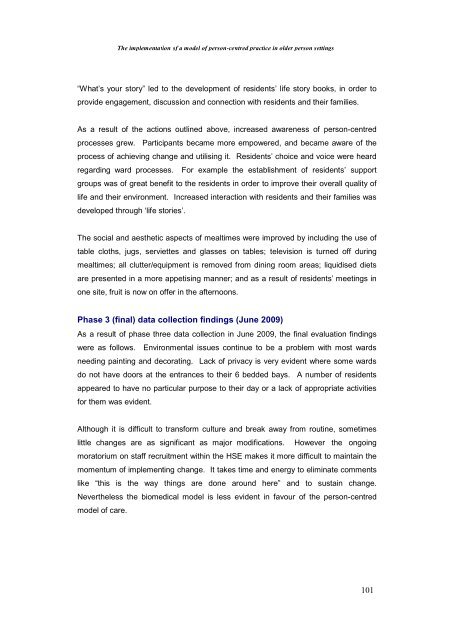The Implementation of a Model of Person-Centred Practice In Older ...
The Implementation of a Model of Person-Centred Practice In Older ...
The Implementation of a Model of Person-Centred Practice In Older ...
You also want an ePaper? Increase the reach of your titles
YUMPU automatically turns print PDFs into web optimized ePapers that Google loves.
<strong>The</strong> implementation <strong>of</strong> a model <strong>of</strong> person-centred practice in older person settings<br />
“What’s your story” led to the development <strong>of</strong> residents’ life story books, in order to<br />
provide engagement, discussion and connection with residents and their families.<br />
As a result <strong>of</strong> the actions outlined above, increased awareness <strong>of</strong> person-centred<br />
processes grew. Participants became more empowered, and became aware <strong>of</strong> the<br />
process <strong>of</strong> achieving change and utilising it. Residents’ choice and voice were heard<br />
regarding ward processes. For example the establishment <strong>of</strong> residents’ support<br />
groups was <strong>of</strong> great benefit to the residents in order to improve their overall quality <strong>of</strong><br />
life and their environment. <strong>In</strong>creased interaction with residents and their families was<br />
developed through ‘life stories’.<br />
<strong>The</strong> social and aesthetic aspects <strong>of</strong> mealtimes were improved by including the use <strong>of</strong><br />
table cloths, jugs, serviettes and glasses on tables; television is turned <strong>of</strong>f during<br />
mealtimes; all clutter/equipment is removed from dining room areas; liquidised diets<br />
are presented in a more appetising manner; and as a result <strong>of</strong> residents’ meetings in<br />
one site, fruit is now on <strong>of</strong>fer in the afternoons.<br />
Phase 3 (final) data collection findings (June 2009)<br />
As a result <strong>of</strong> phase three data collection in June 2009, the final evaluation findings<br />
were as follows. Environmental issues continue to be a problem with most wards<br />
needing painting and decorating. Lack <strong>of</strong> privacy is very evident where some wards<br />
do not have doors at the entrances to their 6 bedded bays. A number <strong>of</strong> residents<br />
appeared to have no particular purpose to their day or a lack <strong>of</strong> appropriate activities<br />
for them was evident.<br />
Although it is difficult to transform culture and break away from routine, sometimes<br />
little changes are as significant as major modifications. However the ongoing<br />
moratorium on staff recruitment within the HSE makes it more difficult to maintain the<br />
momentum <strong>of</strong> implementing change. It takes time and energy to eliminate comments<br />
like “this is the way things are done around here” and to sustain change.<br />
Nevertheless the biomedical model is less evident in favour <strong>of</strong> the person-centred<br />
model <strong>of</strong> care.<br />
101
















